આજે લાપસીની વાત કરવી છે, ઘણો પ્રયત્ન કર્યો આ વિશે અંગ્રેજીમાં લખવાનો પણ મનમાં શબ્દો ગોઠવાયા જ નહીં, પછી થયું કે આપણી લોક વાની ના ગુણ ગાવા હોય, તેના મહિમાની વાત કરવી હોય અને તેના માટે મને બાળપણ થી જે પ્રેમ છે એ હું અંગ્રેજીમાં પ્રસ્તુત નહી કરી શકું. કહેવાય છે ને કે જે ભાષામાં વિચાર આવે તેને તેજ ભાષામાં પ્રસ્તુત કરીએ તો તે હૃદયને વધુ સ્પર્શે.
લાપસી (ઘણા તેને કંસાર પણ કહે) ગુજરાતી ઘરોમાં શુભ કામ અને અવસરો /પ્રસંગોને આવકારવા બનતી વાનગી છે. જ્યારે ઘરના વડીલ ‘લાપસીના આંધણ મુકો ‘એમ કહે એટલે સમજવું કે કાંઇ સરસ કામ થવા જઈ રહ્યું છે. તહેવાર, લગ્ન, સીમંત, જન્મ, વાસ્તુ, કુળદેવીનો પ્રસાદ આ બધું લાપસીથી શરૂ થાય ને ઉજવાય.
અમે મૂળ કાઠિયાવાડના અને એમાંય પાછા ભાલ પંથકના. અમારે ત્યાંના દાઉદખાની/ભાલીઆ/છાસીઆ ઘઉં બહુ પ્રખ્યાત (હવે તો એ GI tagged છે)અને કદાચ એજ કારણ છે કે અમને ભાત કરતાં ભાખરી વધુ ભાવે. એમ કહેવાય છે કે ભાલીઆ ઘઉંના લાડુ, લાપસી, ભાખરી, પુરી અદ્ભુત બને. જીભે ચઢે પણ દાંતે ન ચોંટે તેવા, એકદમ ફરસ્તા.એની ફૂલકાં રોટલી એટલી સારી ન બને એટલે જ કદાચ અમારી રોટલી અમદાવાદીઓ ની રોટલી જેટલી પતલી ન બને.
હું એક બહુ મોટા સંયુક્ત કુટુંબમાં મોટી થઈ અને એ જમાનામાં પ્રચલિત હતું તેમ આખા વર્ષ ચાલે એટલા ઘઉ,ચોખા, તેલ, મસાલા, લસણ, ગોળ વગેરે ભરાતા. અમારા ઘરના કોઠારનું વ્યવસ્થાપન અમારા બા સંભાળતા. ઘઉં ભરવાનું કામ મારા બા ઉપાડે અને પાર પડાવે. મને યાદ છે કે અમે લગભગ ૧૧ થી ૧૨ મોટી બોરી ઘઉં ભરતા-એટલે 1100 કિલો ઘઉં. ગોલણો પાસે તેને સાફ કરાવાય, દિવેલથી મોવાય અને પછી તડકે તપી સાફ થયેલા પીપડામાં ભરાવાય. “દિવેલ ચઢેલા, વર્ષ દરમિયાન ઠરતા ઘઉં પચવામાં સારા રહે,” એમ બા કહેતા. નવા ભરેલા ઘઉંનું સૌથી પહેલું દળણુ લાપસીનું થતું. કાંઇ બીજું બને તે પહેલાં નવા ઘઉંની લપસી બનતી.
વાસી ભાખરીનું ચૂરમું, પછી લાપસી એ મારું સૌથી પ્રિય ભોજન. સરસ સીજાયેલી લાપસીમાં ગરમ ઘી અને દળેલી ખાંડ ચોળી ખાવા મળે એની હું રાહ જોતી. ચૂરમું તો છાસવારે બનતું પણ લાપસી તો કાંઇ સામાન્ય નહોતી. એને માણવા સારા પ્રસંગની રાહ જોવી પડતી.
દાયકાઓ પછી મેં પણ વર્ષ માટે ઘઉં ભરવાનું ચાલુ કર્યું અને એ પણ પાછા ભાલીઆ ઘઉં ભર્યા. પહેલાંની જેમ ગોલણોની ટુકડી નથી તેડાવી પણ ઘઉં સાફ થઈ દિવેલથી મોવાઈને ખેડૂતને ત્યાંથી તૈયાર થઈ આવ્યા.
મેં પણ મારાં બા કરતાં એમ તેમાંથી પહેલા લાપસી બનાવવાનું નક્કી કર્યું. પણ એ પહેલાં મારે તે શીખવી પડે તેમ હતું. મારાં મમ્મી દક્ષિણ ગુજરાતના, તે બાજુ આ લાપસી કરતા ફાડા લાપસી/બાટ વધુ પ્રચલિત. આ લાપસી મારા તેમને નોહતી આવડતી, હું મારા કાકીના હાથની લાપસી ખાઈ મોટી થયેલી. હવે લાપસી બનાવવાની જવાબદારી મારાં મોટા ભાભીના માથે છે. શીખવા ગઈ ત્યારે આ વિડીયો બનાવ્યો. મારા કાકીને લાપસીના મહિમાની વાત કરવા કહ્યું અને ભત્રીજી રાજસીને લાપસી ચોળીને કેમ ખવાય તે દર્શાવવા કહ્યું. ઘણી યાદો તાજી થઈ અને ફરી પાછી લાપસી ખાવાની એજ મઝા અનુભવી.
આ લાપસીને ઘણા વેલણ લાપસી પણ કહે છે કારણ કે તેને હલાવવા વેલણની મદદ લેવાય, કડછો/તાવેથો આમાં ન ચાલે. વેલણથી હલાવવાને કારણે તેમાં લખોટી જેટલી નાની નાની ગોળીઓ બને ને તે જ આ લાપસીની ખરી લાક્ષણિકતા છે.
આપણી ભાષા મા કંસાર – લાપસી ને લગતા રૂઢિપ્રયોગો.
કંસાર
કંસાર ચોળવો —- કંસારમાં ઘી મેળવવું-સુભગ મિલન કરાવવું.
કંસારના આંધણ મુકવા —- શુભ થવાની આગાહી
ગોળ વિના મોળો કંસાર —- સાધન વગર સાધ્ય નકામું બની રહે.
કરવા ગયા કંસાર ને થઈ ગઈ થૂલી —- કામમાં સફળતા ન મળે પણ વિપરીત ફળ મળે, સારું કરવા જતા કામ બગડવું
કંસારમાં મીઠું નાખવું —— સારા કામમાં વિઘ્ન નાખી બગાડવું
કંસારમાં કાંકરી આવે —– સારા કામમાં એકાદ તો ખરાબ વસ્તુ હોય, સારા કામમાંય વિઘ્ન તો હોય.
લાપસી
લાપસીના આંધણ મુકવા —- શુભ કાર્ય થવાની સંભાવના હોવી
લાપસીમાં લીટા હોવા—- માલ-મલીદાની જોગવાઈ હોવી.
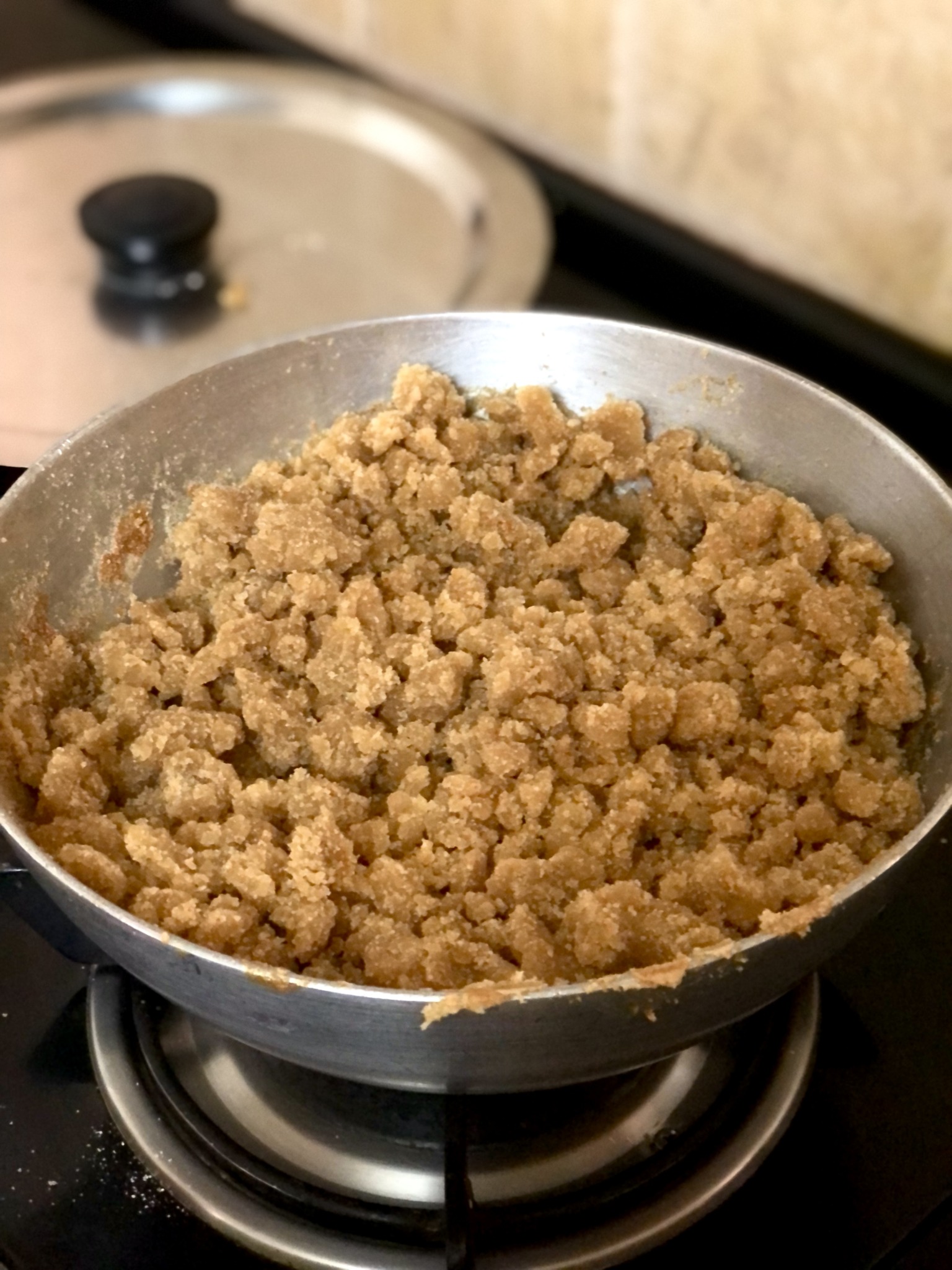
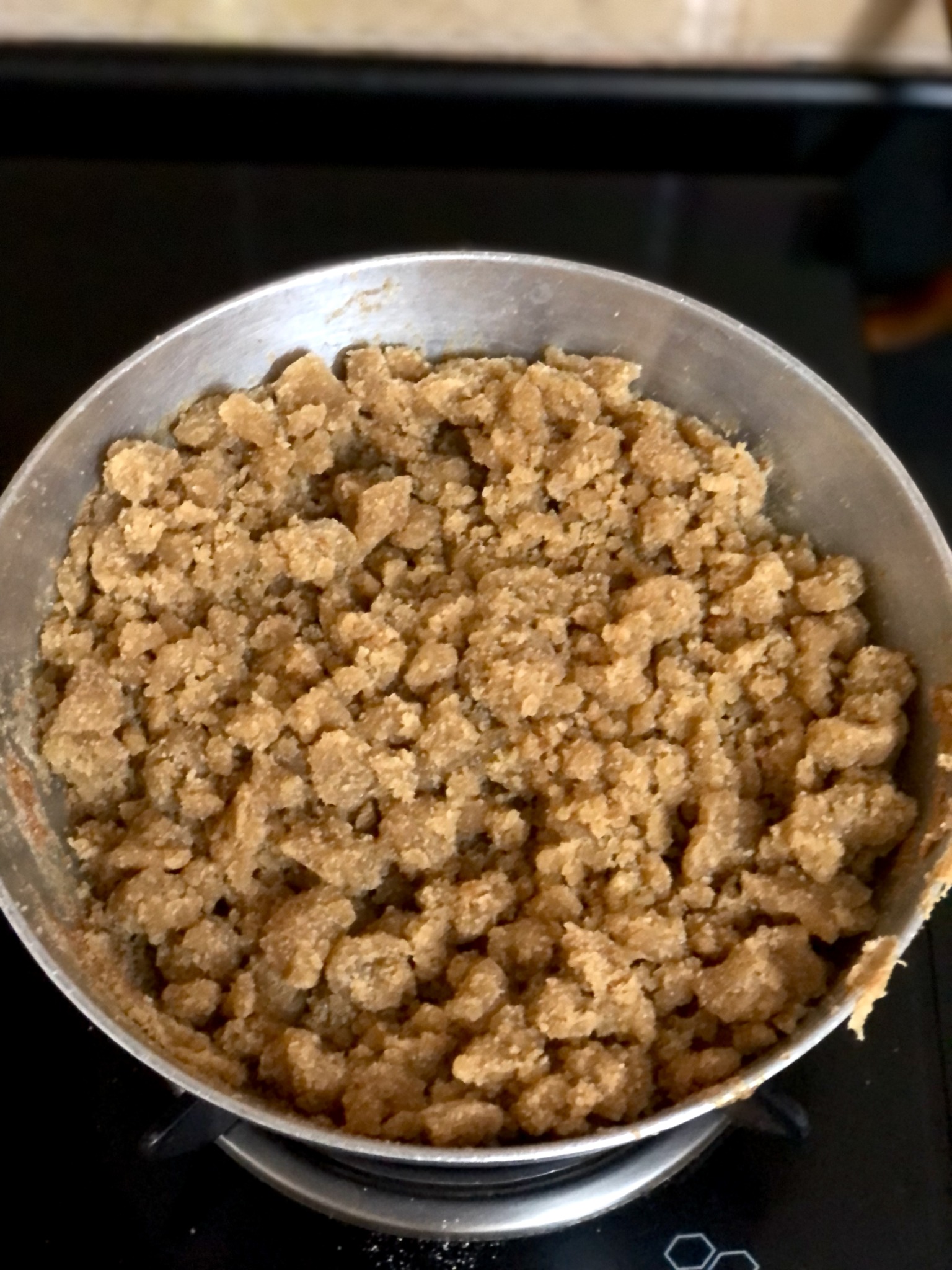
This is how a well made Lapsi should look. A simple dish does, it does need some skill to get it right. All good things are celebrated with a bowl of Lapsi, festivals and celebrations are incomplete if Lapsi is not part of the meal.
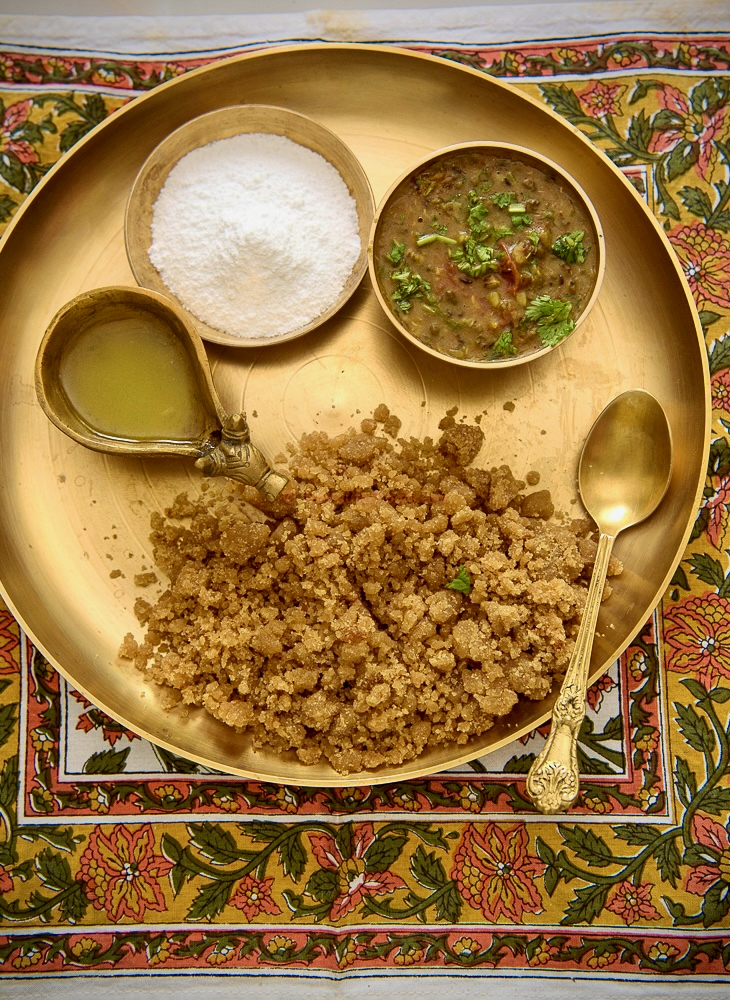
Lapsi - crumble made the Gujarati way
Ingredients
- 2 cups water
- 1 +1/4 cups jaggery, shredded
- 2+1/2 cups whole wheat flour, coarse ground (Bhabhiji prepares bhakhri flour)
- 2 tablespoon + 1/4 cup + 2 tablespoon ghee
Instructions
Place a wide and deep heavy bottom sauce pan over medium flame.
Add water into the saucepan, after it heats up drop in the shredded jaggery.
Allow the jaggery added water to boil for 4-5 minutes.
In the meantime, sieve the flour in a wide plate/thali.
Add 1/4 cup ghee and nicely rub it into the flour.
Once the water has boiled enough, add 2 tablespoons ghee to it.
Stir well with the back of the wooden spoon or take thin rolling pin.
Reduce the flame to low.
Now scatter the flour over the simmering water, poke holes on the surface.
The water will gradually rise through the holes and wet the flour, coax the water to rise to the top from the sides by making space with the help of rolling pin.
Few minutes into the cook, break the soaked flour with help of rolling pin (as seen in the following video).
Stir it all well, but with gentle hands. If you apply force the lapsi will come together like a dough.
Cover and cook and repeat the process couple of times every 2-3 minutes. By stirring at regular interval we are breaking the lapsi into smaller balls, each time the size of the balls will grow smaller.
After 10 minutes the lapsi should be cooked, press between your finger and thumb to check the doneness. If it does not stick to the hands the lapsi is done.
Turn off the flame. Keep the Lapsi covered as it will continue to cook in residual heat. Ever 5 minutes, give it a stir to break the balls. Cover after each stir.
By the end the lapsi would have broken into marble sized balls and the rolling pin will have nothing sticking to it after the stir.
The Lapsi will also feel light, and stirring it through rolling pin will become much easy.
In the end, stir in couple of spoon full of ghee.
Serve hot or at room temperature with warm ghee and ground sugar.
Lapsi is first offered to family deity and then enjoyed as Prasad. It is served along with a mung bean curry.
Notes
Always maintain low flame. The stirring with rolling pin is to be done with gentle hands.


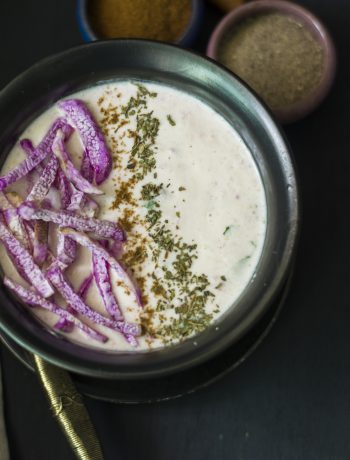
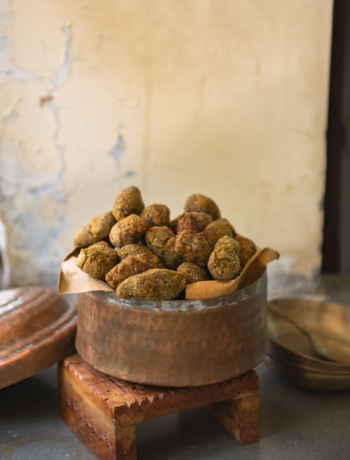
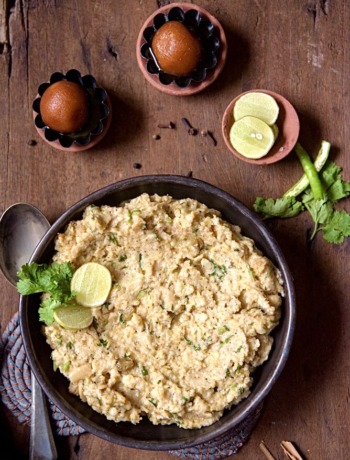
No Comments